The subscription business models come in many ways and forms. There are many advantages attached to it for organizations that have such a model. From SaaS (Software-as-a-Service) to fitness memberships, every business can use subscription models. It’s not just a trend; it’s a transformative approach that has reshaped the way we access products and services. As technology has taken over, where change is the only constant, the subscription business model has emerged as a powerful and transformative force. It’s not merely a passing trend; it’s a revolutionary approach that has reshaped the way we consume products and services. Far from being a mere passing fancy, these models have revolutionized the way products and services are accessed and consumed.
Read more on What are Subscription Business Models? How are they beneficial to customers and the organization?
What are subscription business models?
A subscription business model is a structured approach where customers pay a recurring fee at regular intervals, often monthly or annually, in exchange for continuous access to a product or service. The subscription model has disrupted various industries, from media and entertainment to software, and even consumer goods.
How do subscription business models work?
The working of subscription business models can be broken down into key components:
1. Offering
Organizations provide a product or service that is well-suited for a subscription model. This can include software, streaming content, cloud storage, cosmetics, meal kits, and more.
2. Pricing
Customers are charged at regular intervals, often on a monthly or yearly basis. The pricing structure can vary, offering different tiers or packages to cater to different customer needs.
3. Customer Retention
One of the critical aspects of subscription models is customer retention. Organizations aim to provide ongoing value to subscribers to keep them engaged and prevent churn.

4. Customer Experience
A seamless and positive customer experience is vital. Easy sign-up, user-friendly interfaces, and responsive customer support are essential elements.
Why Subscription Business Models Are Taking Charge?
Subscription business models have witnessed remarkable growth due to several factors:
1. Convenience
Customers appreciate the convenience of subscription services. They can access products and services without the hassle of purchasing them individually.
2. Predictable Revenue
For organizations, subscription models offer predictable and recurring revenue streams. This stability allows for better financial planning and growth strategies.
3. Ongoing Relationship
Subscriptions foster ongoing relationships between customers and organizations. This connection can lead to a deeper understanding of customer needs and preferences.
4. Scalability
The model is highly scalable, as it allows organizations to reach a broader audience without significantly increasing overhead costs.
5. Data Insights
Subscriptions provide valuable data on customer behavior and preferences. This data can be leveraged for product improvement and targeted marketing.
Benefits to Organizations
Let’s delve into the specific advantages that subscription business models offer to organizations:
1. Predictable Revenue
Organizations can rely on a stable cash flow due to subscription revenue. This predictability allows for better financial planning and long-term strategic investments.
2. Customer Loyalty
Subscribers often exhibit higher loyalty compared to one-time purchasers. Organizations can build lasting relationships, leading to reduced churn rates and increased customer lifetime value.

3. Lower Customer Acquisition Costs
Acquiring new customers can be expensive. Subscription models can significantly reduce these costs, as existing customers renew their subscriptions, and word-of-mouth referrals contribute to growth.
4. Valuable Data Insights
The data collected from subscribers can be a goldmine of insights. Organizations can fine-tune their offerings, marketing, and customer experience based on this data, making informed decisions.
5. Sustainable Growth
With subscription models, organizations can achieve sustainable growth, even in highly competitive markets. As the customer base grows, revenue increases without proportionate operational expansion.
6. Market Expansion
Subscriptions often transcend geographical boundaries. This allows organizations to reach a global audience, expanding their market presence.
7. Flexibility
Organizations can adapt and innovate their offerings more easily within the subscription model, keeping up with evolving customer preferences and technological advancements.
Benefits to Customers
Subscription business models also bring substantial benefits to customers:
1. Cost Savings
Subscriptions often provide cost savings compared to individual purchases. Customers can access a range of products and services for a single monthly fee.
2. Convenience
Customers enjoy the convenience of automatic access without the need for repeated purchasing or renewal processes.

3. Personalization
Many subscription models offer personalized experiences. Customers receive tailored recommendations and content, enhancing their satisfaction.
4. Early Access and Exclusive Content
Subscribers often gain early access to new features, products, or exclusive content, enhancing their overall experience.
5. Reduced Commitment Risk
In some cases, subscription models offer flexible plans that allow customers to cancel or change their subscriptions as needed, reducing commitment risk.
Conclusion:
Subscription business models have revolutionized the way organizations offer and customers access products and services. Their success is no accident; it’s the result of delivering convenience, predictability, ongoing relationships, and valuable insights. These models have transformed industries and continue to drive innovation and growth. For organizations, the benefits are numerous, including predictable revenue, customer loyalty, cost savings, and scalable growth. For customers, subscriptions provide convenience, personalization, and reduced commitment risk.
In a world where flexibility, adaptability, and customer-centricity are paramount, subscription business models have become the gold standard. They not only represent a fundamental shift in business operations but also a testament to the power of continuous engagement and meaningful customer relationships. Whether you’re on the business or consumer side of the equation, the subscription business model has become an integral part of our modern economic landscape, offering value, convenience, and lasting partnerships.







